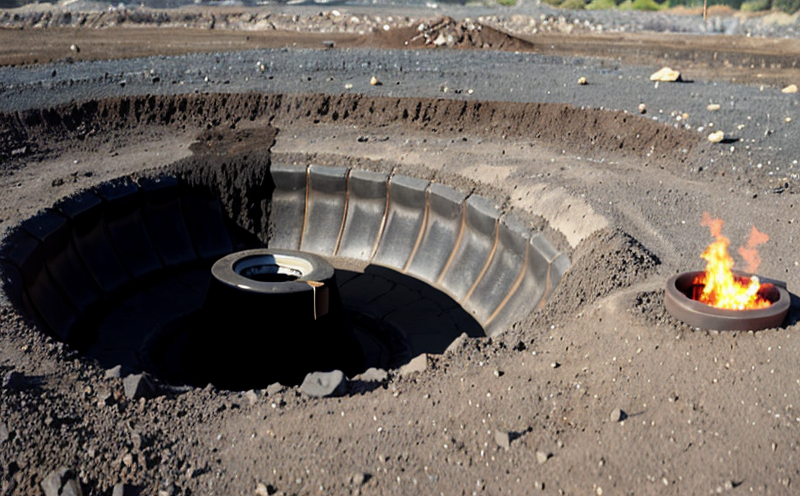ASTM D4239 Sulfur in Coal by Infrared Absorption Testing
The ASTM D4239 standard specifies an infrared absorption method to determine the sulfur content of coal. This testing procedure is essential for ensuring compliance with environmental regulations and optimizing fuel performance in industrial processes.
Sulfur content in coal significantly impacts its combustion efficiency, emissions, and overall quality. High levels of sulfur can lead to increased acidity in flue gases, which may corrode equipment and contribute to air pollution. By accurately measuring the sulfur content using ASTM D4239, industries can ensure that they meet environmental standards while optimizing fuel performance.
The testing process involves several steps: sample preparation, drying, ashing, and combustion. The prepared coal sample is combusted in an oxygen-rich environment at a specified temperature (typically between 1050°C to 1200°C). The sulfur dioxide produced during this combustion process is then measured using infrared spectroscopy.
Infrared absorption spectra provide precise information about the types and concentrations of gases present. For ASTM D4239, the focus is on detecting sulfur dioxide (SO₂) within the sample. This method allows for a non-destructive analysis, ensuring that the coal sample remains intact after testing.
The accuracy and reliability of the test are paramount in maintaining compliance with international standards such as ISO 15149 and ASTM D4239 itself. These standards ensure that the sulfur content is reported consistently across different laboratories, allowing for accurate comparisons and quality control measures.
Sample Preparation
Proper sample preparation is critical to obtaining accurate results from ASTM D4239 testing. Coal samples should be representative of the batch or lot being tested. Initial steps include grinding the coal sample into a fine powder, which ensures complete combustion during the test.
Drying and Ashing
Before combustion, the powdered coal sample is dried to remove moisture content. This step prevents errors caused by water vapor interfering with the infrared absorption measurements. The sample is then subjected to ashing in a muffle furnace at 510°C for 6 hours. Ashing removes impurities and ensures that only the sulfur-containing compounds are combusted.
Combustion
The dried, ashed coal sample is then placed into an oxygen-rich combustion chamber. The temperature should be controlled to within ±25°C of the specified range (1050°C to 1200°C). Combustion occurs rapidly, and sulfur dioxide gas is produced immediately. This gas is collected and analyzed using infrared spectroscopy.
Analysis
The combustion gases are passed through a detector that measures the intensity of light absorbed by SO₂ at specific wavelengths. The amount of light absorbed correlates directly with the concentration of SO₂ in the sample. Data from multiple scans can be averaged to provide an accurate sulfur content measurement.
Reporting
The results of ASTM D4239 testing are typically reported as a percentage of total sulfur by mass. This value represents the sulfur content in the coal sample according to the standard procedure. Reporting should include all relevant parameters such as temperature, humidity levels during preparation, and any deviations from the specified protocol.
Applications
This testing method finds applications across various industries including power generation, petrochemicals, and metallurgy. By ensuring that coal samples meet environmental regulations, these industries can minimize their carbon footprint while optimizing fuel efficiency.
- Environmental Compliance: Ensures compliance with international standards such as ISO 15149 and local regulations.
- Fuel Optimization: Helps in identifying the most efficient coal types for specific applications.
- Emissions Control: Allows for precise monitoring of sulfur emissions, aiding in pollution control efforts.
Why It Matters
The importance of ASTM D4239 testing cannot be overstated. Sulfur content directly influences the performance and environmental impact of coal-based fuels. Accurate measurement ensures that industries comply with stringent emission limits set by regulatory bodies like the EPA (Environmental Protection Agency) in the U.S., the EU, and other international standards.
Benefits
- Precise Sulfur Content Measurement: Ensures accurate reporting of sulfur content according to ASTM D4239.
- Compliance Assurance: Helps in meeting environmental regulations and ensuring sustainable practices.
- Fuel Efficiency Optimization: Identifies the most efficient coal types for specific industrial processes.
- Emissions Reduction: Aids in reducing sulfur emissions, contributing to cleaner air and lower carbon footprints.
- Data Accuracy: Provides consistent results across different laboratories, enhancing data reliability.
- Regulatory Compliance: Ensures that coal samples meet the strictest international standards.





